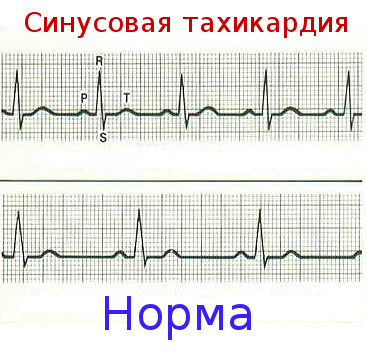Sinus tachycardia: различия между версиями
Материал из CardioWiki
Wikiadmin (обсуждение | вклад) (Новая страница: «en:Sinus tachycardia ru:Синусовая тахикардия справа<b>Sinus tachycardia</…») |
Wikiadmin (обсуждение | вклад) |
||
| Строка 1: | Строка 1: | ||
[[en:Sinus tachycardia]] | [[en:Sinus tachycardia]] | ||
[[ru:Синусовая тахикардия]] | [[ru:Синусовая тахикардия]] | ||
| − | [[Файл:СинусоваяТахикардия.jpg|справа]]<b>Sinus tachycardia</b> is a form of supraventricular tachyarrhythmia, characterized by an accelerated [[sinus cardiac pacemaker|sinus rhythm]] (i.e., the rhythm of the sinus node) with a heart rate of more than 90 | + | [[Файл:СинусоваяТахикардия.jpg|справа]]<b>Sinus tachycardia</b> is a form of supraventricular tachyarrhythmia, characterized by an accelerated [[sinus cardiac pacemaker|sinus rhythm]] (i.e., the rhythm of the sinus node) with a heart rate of more than 90 beats per minute in adults. |
Clinical value has a sinus tachycardia, which remains at rest. Often it is accompanied by unpleasant sensations of "palpitation", a feeling of lack of air, although some patients may not notice an increase in heart rate. The causes of such a tachycardia can be both extracardiac factors, and actually heart disease. | Clinical value has a sinus tachycardia, which remains at rest. Often it is accompanied by unpleasant sensations of "palpitation", a feeling of lack of air, although some patients may not notice an increase in heart rate. The causes of such a tachycardia can be both extracardiac factors, and actually heart disease. | ||
| Строка 9: | Строка 9: | ||
# maintaining the right [[sinus cardiac pacemaker|sinus rhythm]]; | # maintaining the right [[sinus cardiac pacemaker|sinus rhythm]]; | ||
# positive P wave in leads I, II, aVF, V4-V6; | # positive P wave in leads I, II, aVF, V4-V6; | ||
| − | # with a pronounced sinus tachycardia, the PQ (R) interval is shortened (but not less than 0.12 s) and the duration of the QT interval is decreased, the amplitude of P wave in the leads I, II, aVF is increased, the amplitude of the T wave is increased or decreased, the | + | # with a pronounced sinus tachycardia, the PQ (R) interval is shortened (but not less than 0.12 s) and the duration of the QT interval is decreased, the amplitude of P wave in the leads I, II, aVF is increased, the amplitude of the T wave is increased or decreased, the upslopping ST segment depression(not more than 1.0 mm below the isoline). |
Версия 12:23, 24 марта 2017
Sinus tachycardia is a form of supraventricular tachyarrhythmia, characterized by an accelerated sinus rhythm (i.e., the rhythm of the sinus node) with a heart rate of more than 90 beats per minute in adults.
Clinical value has a sinus tachycardia, which remains at rest. Often it is accompanied by unpleasant sensations of "palpitation", a feeling of lack of air, although some patients may not notice an increase in heart rate. The causes of such a tachycardia can be both extracardiac factors, and actually heart disease.
Sinus tachycardia is characterized by:
- increase in heart rate more than 90 beats per minute;
- maintaining the right sinus rhythm;
- positive P wave in leads I, II, aVF, V4-V6;
- with a pronounced sinus tachycardia, the PQ (R) interval is shortened (but not less than 0.12 s) and the duration of the QT interval is decreased, the amplitude of P wave in the leads I, II, aVF is increased, the amplitude of the T wave is increased or decreased, the upslopping ST segment depression(not more than 1.0 mm below the isoline).

